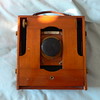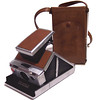Difference between revisions of "Folding"
m |
|||
| Line 3: | Line 3: | ||
A '''folding camera''', or '''folder''', is a camera with [[bellows]] that can be folded so that the camera occupies less space when not in use. | A '''folding camera''', or '''folder''', is a camera with [[bellows]] that can be folded so that the camera occupies less space when not in use. | ||
| − | Not all bellows cameras can be called folding: a [[monorail view camera]] has bellows, but it cannot be folded (at least not "folded into itself") and instead provides flexibility for "movements" (as well as allowing some compression for relative ease of transportation). Other [[large format]] view cameras are foldable, then called [[field camera]]s for their portability. | + | Not all bellows cameras can be called folding: a [[monorail view camera]] has bellows, but it cannot be folded (at least not "folded into itself") and instead provides greater flexibility for "movements" (as well as allowing some compression for relative ease of transportation). Other [[large format]] view cameras are foldable, then called [[field camera]]s for their portability. |
| − | Some press | + | Some [[press camera]]s (like the [[Busch Pressman Model D]]) allow tilts and shifts but also fold for compactness. However, the great majority of folding cameras force the lens board and image plane to be parallel (no tilts), and force the lens and image frame to centre on an axis perpendicular to these two planes (no shifts). This reduces the function of the bellows to the saving of space. |
The scope of the term ''folding camera'' is unclear. While there is no dispute that the [[Agfa PB 20]] is a folding camera, cameras such as the [[Plaubel Makina]] that employ bellows and hinges to collapse when not in use, but for which neither the lens assembly or its cover is hinged in relation to the body, are regarded by some people as ''strut folding'' cameras, but are not regarded by others as "folding" cameras. | The scope of the term ''folding camera'' is unclear. While there is no dispute that the [[Agfa PB 20]] is a folding camera, cameras such as the [[Plaubel Makina]] that employ bellows and hinges to collapse when not in use, but for which neither the lens assembly or its cover is hinged in relation to the body, are regarded by some people as ''strut folding'' cameras, but are not regarded by others as "folding" cameras. | ||
| Line 28: | Line 28: | ||
</div> | </div> | ||
| − | Putting aside strut folders ( | + | Putting aside strut folders (indeed they are folders), we can divide folders into two. A very small minority, exemplified by the [[Voigtländer Vitessa]], have "barn doors": a symmetrical pair of doors. The others have a single door. A distinction is often drawn according to whether the bed hinges "vertically" or "horizontally" (that is, if the camera's longest dimension is vertical or horizontal when the bed is unfolded towards the bottom). The great majority of 6×6 folders are horizontal folders; the great majority of 4.5×6 and 6×9 folders are vertical folders. |
== Development == | == Development == | ||
| − | The | + | The early folding cameras were compact amateur [[view camera]]s, plate cameras of the [[folding bed camera|folding bed]] type. Other than common view cameras the whole camera was securely enclosed in its body when folded. |
| − | |||
{{Flickr_image | {{Flickr_image | ||
|image_source= http://www.flickr.com/photos/n6nkn/147141592/ | |image_source= http://www.flickr.com/photos/n6nkn/147141592/ | ||
| Line 39: | Line 38: | ||
|image_text= <small>The c.1925 [[Icarette|Icarette D]] needed<br>the lens standard pulled forward<br>after opening</small> | |image_text= <small>The c.1925 [[Icarette|Icarette D]] needed<br>the lens standard pulled forward<br>after opening</small> | ||
}} | }} | ||
| − | The typical rollfilm folding camera of the 1920s needs to | + | The typical rollfilm folding camera of the 1920s is a [[folding bed camera]]. Its lens assembly needs to be pulled out along rails on its opened hinged front door. The [[leaf shutter]] has a small lever for cocking and another for firing; it also allows a [[cable release]] to be screwed in. (The screw dimensions are the same as those used in those of today's cameras.) Film is advanced with a key or knob; one stops winding when the new number appears in a [[red window|red or orange window]] on the back. There is no rangefinder, and the only viewfinder is a swivelling [[brilliant finder]] attached to the front of the lens. There is no pressure plate to hold the film in the right plane. |
{{Flickr_image | {{Flickr_image | ||
Revision as of 22:32, 23 December 2008
For a list of folding cameras, see Category: Folding.
A folding camera, or folder, is a camera with bellows that can be folded so that the camera occupies less space when not in use.
Not all bellows cameras can be called folding: a monorail view camera has bellows, but it cannot be folded (at least not "folded into itself") and instead provides greater flexibility for "movements" (as well as allowing some compression for relative ease of transportation). Other large format view cameras are foldable, then called field cameras for their portability.
Some press cameras (like the Busch Pressman Model D) allow tilts and shifts but also fold for compactness. However, the great majority of folding cameras force the lens board and image plane to be parallel (no tilts), and force the lens and image frame to centre on an axis perpendicular to these two planes (no shifts). This reduces the function of the bellows to the saving of space.
The scope of the term folding camera is unclear. While there is no dispute that the Agfa PB 20 is a folding camera, cameras such as the Plaubel Makina that employ bellows and hinges to collapse when not in use, but for which neither the lens assembly or its cover is hinged in relation to the body, are regarded by some people as strut folding cameras, but are not regarded by others as "folding" cameras.
Putting aside strut folders (indeed they are folders), we can divide folders into two. A very small minority, exemplified by the Voigtländer Vitessa, have "barn doors": a symmetrical pair of doors. The others have a single door. A distinction is often drawn according to whether the bed hinges "vertically" or "horizontally" (that is, if the camera's longest dimension is vertical or horizontal when the bed is unfolded towards the bottom). The great majority of 6×6 folders are horizontal folders; the great majority of 4.5×6 and 6×9 folders are vertical folders.
Development
The early folding cameras were compact amateur view cameras, plate cameras of the folding bed type. Other than common view cameras the whole camera was securely enclosed in its body when folded.

|
| The c.1925 Icarette D needed the lens standard pulled forward after opening |
The typical rollfilm folding camera of the 1920s is a folding bed camera. Its lens assembly needs to be pulled out along rails on its opened hinged front door. The leaf shutter has a small lever for cocking and another for firing; it also allows a cable release to be screwed in. (The screw dimensions are the same as those used in those of today's cameras.) Film is advanced with a key or knob; one stops winding when the new number appears in a red or orange window on the back. There is no rangefinder, and the only viewfinder is a swivelling brilliant finder attached to the front of the lens. There is no pressure plate to hold the film in the right plane.

|
| self-erecting Belfoca |
Its successor of the 1930s is self-erecting: as one unhinges the bed, the lens pops forward. (It may be necessary to pull it a little further, so that it clicks into position.) The brilliant finder is supplemented by some other viewfinder, also very rudimentary even by the standards of the 1950s. There may be a mask to allow a choice between two formats (e.g. 4.5×6 and 6×9).

|
| 1953 Franka Solida |
By the 1950s, the brilliant finder is gone and a viewfinder, perhaps with integrated rangefinder, is under a rigid housing. The shutter still needs to be cocked, but the shutter release is now on the body. There is certainly a film pressure plate; either this has one or more holes for red windows, or there are no holes and no red windows as film advance is semi-automatic. The lens is focussed in one of three ways:
- the frontmost element alone is moved ("front-cell focussing"): optically the least satisfactory solution and normal in cheap cameras, but sometimes used for expensive and highly regarded cameras too
- all the elements of the lens are moved forward and backward together ("unit focussing"): this can be achieved by mounting the lens and shutter assembly on an helical ("helicoid focussing"), or on a strut that moves along a rail or is displaced in some other way
- the film is moved forward and back while the lens is kept stationary ("film-plane focussing"): the least common of the three systems
There have been folding cameras in all kinds of format, from 18×24 mm to at least 18×24 cm.















